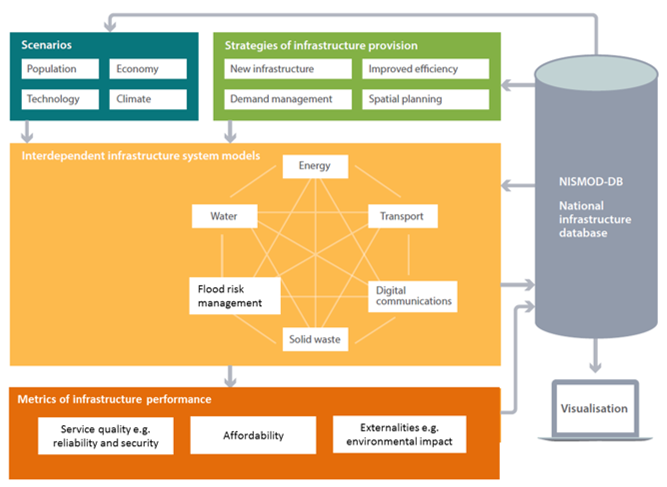ABOUT US / WHAT WE DO / INTERDEPENDENCIES IN INFRASTRUCTURE SYSTEMS-OF-SYSTEMS
INTERDEPENDENCIES IN INFRASTRUCTURE SYSTEMS-OF-SYSTEMS
Infrastructure networks have been designed and evolved as sector-specific entities: electricity, gas, road, rail, digital communications and so on. They inevitably have interdependencies between each other, but these have not, until relatively recently, attracted a great deal of attention.
One network operator (e.g. a water utility) has tended to assume that the networks upon which it is dependent (e.g. electric power, transport for the delivery of chemicals) will continue to function come-what-may. That optimistic assumption has been shattered by a series of damaging and disruptive incidents. This points to a process of rapid technological convergence upon electricity as the dominant energy vector and digital connectivity being essential for all infrastructure networks to function. These are not the only interdependencies, but they are the most ubiquitous and are becoming reinforced by the dominant direction of technological change, towards electrification (in part motivated by the desire to decarbonise the power sector) and digitisation.
Other significant forms of interdependence include the dependence of most thermoelectric power plants upon water for cooling, and the dependence of practically all infrastructure upon transport networks (mostly roads) to transport workers to infrastructure sites, even during catastrophic events.
Interdependencies also bring opportunities, for example by using the batteries in electric vehicles to store electricity from renewable energy supplies and better match electricity demand with supply. Risks of water shortage in many parts of the world mean that there are increasing efforts, led by countries like Singapore and Israel, to ‘close the urban water cycle’ by directly reusing ‘waste’ water in sewage for urban and agricultural water supplies. There is also growing interest in the ways in which green infrastructure (like green spaces and wetlands in urban areas) can substitute for ‘grey’ infrastructure, often by providing multiple services like sustainable urban drainage, purification of waste water and cooling urban areas (through shade and transpiration).
These interdependencies influence every-day planning for infrastructure investment and operation, and they influence infrastructure performance during extreme events. Planning one infrastructure network in isolation will overlook crucial interdependencies. The Infrastructure Transitions Research Consortium (ITRC) proposes the National Infrastructure Systems Model (NISMOD) framework. The model is designed to explicitly and conveniently incorporate quantified understanding of interdependencies in a system-of-systems methodology.
A framework for infrastructure systems-of-systems analysis
The NISMOD framework has adopted a ‘system-of-systems’ approach to infrastructure, promoting pioneering research on the interdependencies between the following infrastructure sectors: energy (electricity, gas), transport (road, rail, ports, airports), digital communication (fixed, mobile, satellite), water (supply, waste water treatment, drainage, flood protection) and solid waste. The assessment methodology is depicted in the diagram shown in Figure A1.
The NISMOD system-of-systems framework shown in Figure A1 uses scenarios (top left box) to explore uncertainty in a range of possible futures: the global and national economy; population/demography at national and local scales; climate change; technological development.
By examining a wide range of possible scenarios, we can test the sensitivity of infrastructure policies and plans to different possible future states of the world. These scenarios explore the possible range of contextual factors that are largely outside the control of decision makers responsible for national infrastructure. Of course there are feedbacks between the infrastructure system and these factors, notable in terms of regional economic development: provision of infrastructure can stimulate the economy, provide new employment opportunities and hence change where people live. These feedbacks are important to recognise but are also much more difficult to quantify – attempting to model them would introduce additional complexity that for the time being we consider to be unwarranted. We prefer to explore the possible impacts of infrastructure investment on regional economies by using scenarios that test the possibility of additional growth being stimulated by infrastructure provision.
Alongside scenarios, our framework explores one or more infrastructure strategies. Strategies are sequences of infrastructure investments and policy/regulatory interventions that are intended to modify demand for, or provision of, infrastructure services. Strategies must be sufficiently adaptable to cope with uncertain scenarios, for example of population growth. On the other hand, a national infrastructure strategy must give a clear sense of direction about what policies and investments need to be implemented, where and when. The model informs the balance between supply-side and demand-side interventions. For example, over-provision of new infrastructure (supply-side) can result in infrastructure being under-utilised or resources being used inefficiently.
Scenarios and strategies provide the boundary conditions for the cross-sectoral modelling depicted in the centre of the diagram in Figure 1. NISMOD runs in a simulation mode i.e. for a given set of input conditions (scenarios and strategies), the model simulates system performance and compute a series of metrics through the simulation period (typically decades into the future) which can be used to evaluate system performance (see below). NISMOD keeps track of all of the significant interdependencies between infrastructure sectors.

Figure A1: Schematic overview of the use of NISMOD for national infrastructure assessment (adapted from [13]).
NISMOD in a nutshell
|
Scenarios – how can the future look like?
|
|
|
High resolution simulation models
|
|
|
Scaffolding
|
|